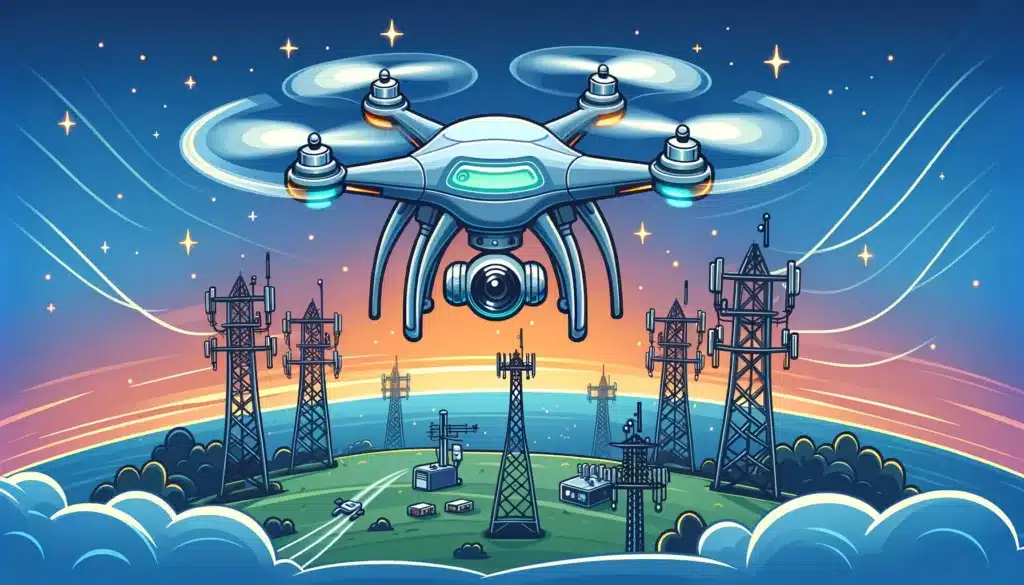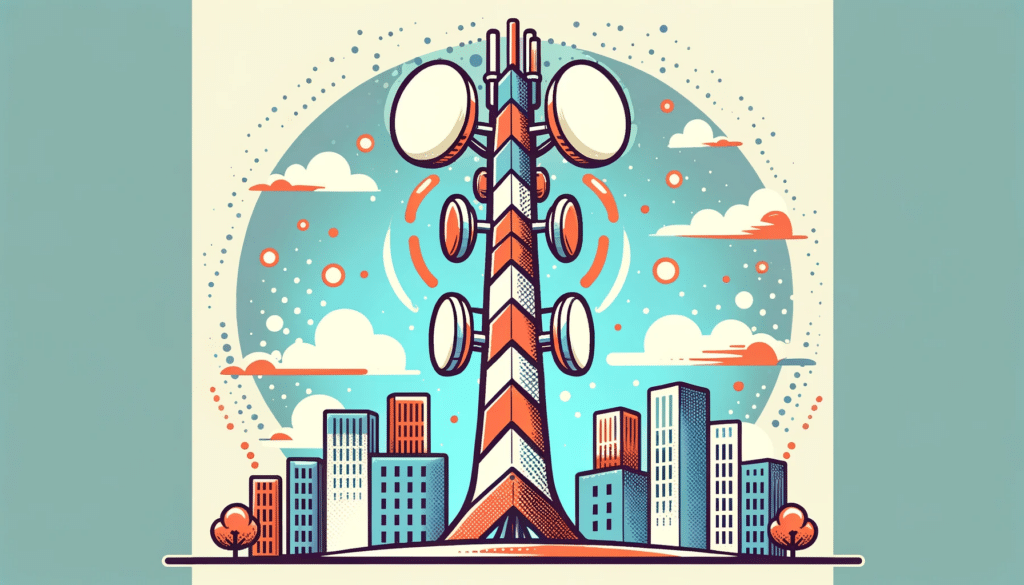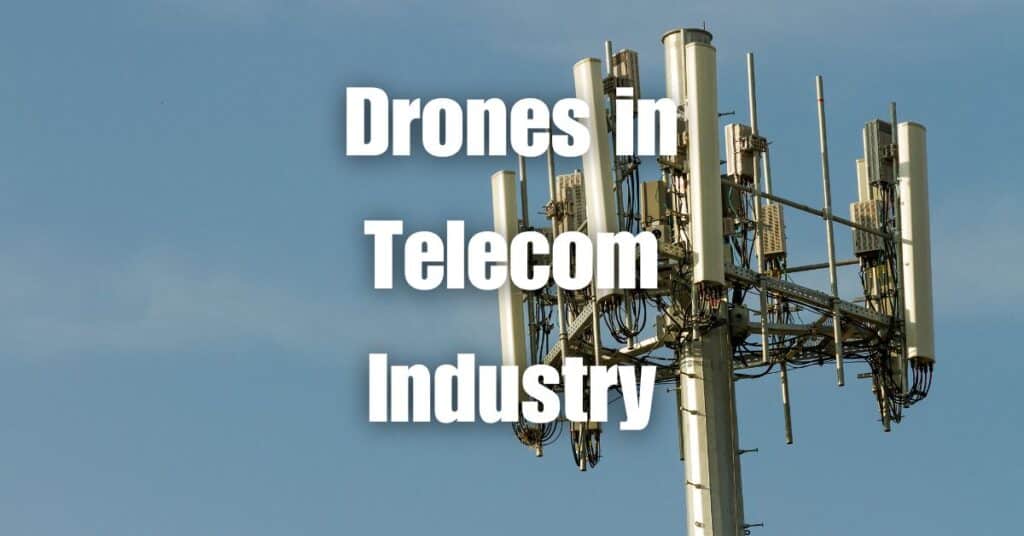The telecommunications industry plays a vital role in keeping us connected, and the integration of drones into this field is revolutionizing how we maintain and expand these networks. As drones in telecommunications industry become increasingly prevalent, they are transforming the way companies approach tower inspections, network expansions, and emergency response.
With benefits such as efficient tower inspections, improved network planning, and cost savings, the use of drones in the telecommunications industry has grown rapidly. In this article, we’ll explore these benefits and discuss the regulations that govern their use. We’ll also take a look at some examples of telecommunications companies using drones to enhance their operations and discuss the future of drones in this industry.
Key Takeaways
- Drone Use in Telecommunications: Drones are increasingly utilized in the telecommunications industry.
- Tower Inspections and Maintenance: They are instrumental for safe and efficient tower inspections.
- Surveying and Mapping: Useful for accurate terrain mapping and site surveys.
- Network Expansion and Connectivity: Assists in expanding network coverage.
- Signal Strength Testing: Drones conduct aerial signal testing to optimize network performance.
- Cost and Safety Benefits: Reduce operational costs and enhance worker safety.
- Regulatory Compliance: Must adhere to specific aviation and privacy regulations.

The Role of Drones in the Telecommunications Industry
Tower Inspections and Maintenance
Drones have become an indispensable tool for tower inspections and maintenance in the telecommunications industry. Equipped with high-resolution cameras and advanced sensors, they can capture detailed images and videos of towers, antennas, and other infrastructure. This allows technicians to assess the condition of the equipment remotely, identify any damage, and plan necessary repairs without having to physically climb the towers. By reducing the need for manual inspections, drones significantly improve safety, save time, and minimize downtime.
Surveying and Mapping
Drones also play a critical role in surveying and mapping for the telecommunications industry. They can rapidly generate accurate 3D models and high-resolution orthomosaic maps of the terrain, helping engineers identify the best locations for new towers or network expansions. Drones can cover large areas quickly, making them ideal for collecting data in remote or hard-to-reach locations. This accelerates the planning process and ensures optimal network coverage.
Network Expansion and Connectivity
As the demand for better and faster connectivity continues to grow, the telecommunications industry must constantly expand and improve its networks. Drones help achieve this by assisting in the installation of new equipment and monitoring the progress of ongoing projects. They can transport small payloads, such as antennas and cables, to hard-to-reach locations, speeding up the deployment process. Drones also enable real-time monitoring of construction sites, ensuring that projects stay on schedule and meet quality standards.
Drone-Assisted Signal Strength Testing
Drones equipped with specialized antennas and signal testing equipment can perform aerial signal strength testing. This helps engineers fine-tune the positioning and alignment of antennas, improving network performance and coverage. By performing these tests with drones, companies can quickly identify weak spots and optimize their networks more efficiently.
Advantages of Using Drones in Telecommunications
Cost Savings
Drones offer significant cost savings in the telecommunications industry by reducing the need for manual labor and expensive equipment. They can quickly perform tasks that would otherwise require specialized equipment or teams of technicians, such as tower inspections, mapping, and network planning. Additionally, drones can minimize downtime by identifying issues before they cause network outages, reducing maintenance costs.
Improved Safety
The use of drones in telecommunications greatly enhances worker safety. Climbing towers for inspections and maintenance can be dangerous, and accidents can result in injuries or even fatalities. Drones eliminate the need for technicians to climb towers in many cases, reducing the risk of accidents and promoting a safer work environment.
Increased Efficiency
Drones can perform tasks more quickly and accurately than humans, increasing efficiency in the telecommunications industry. They can inspect towers, map terrain, and test signal strength in a fraction of the time it would take a team of technicians. This improved efficiency allows companies to better allocate resources and focus on other critical aspects of their operations.
Better Data Collection
Drones equipped with advanced sensors and cameras can collect valuable data that can be used to optimize networks, monitor infrastructure, and plan future expansions. High-resolution imagery, 3D models, and signal strength data provide companies with the information they need to make data-driven decisions and improve their operations.
Efficient Tower Inspections Using Drones
| Traditional Tower Inspection | Drone Tower Inspection |
|---|---|
| Time-consuming | Faster process |
| Higher risk of accidents | Improved safety |
| Limited data collection | Detailed data |
| Requires more manpower | Less manpower needed |
Telecommunications Network Planning with Drone Technology
Drones play a significant role in network planning by providing accurate and up-to-date data on terrain, infrastructure, and signal strength. This information helps engineers design and optimize networks for maximum coverage and performance. By using drone technology, companies can streamline the planning process, reduce costs,

Regulations for Drone Use in the Telecommunications Industry
As drones become more common in the telecommunications industry, it’s essential to be aware of the regulations that govern their use. These regulations are in place to ensure the safety of both drone operators and the general public. Some of the key regulatory aspects include:
Pilot Certification
Drone pilots operating in the telecommunications industry must obtain the necessary certification from their country’s aviation authority. In the United States, for example, pilots are required to hold a Part 107 Remote Pilot Certificate from the Federal Aviation Administration (FAA). This certification demonstrates that the pilot has a thorough understanding of drone regulations, airspace restrictions, and safety procedures.
Drone Registration
Drones used for commercial purposes, such as in the telecommunications industry, must be registered with the relevant aviation authority. This registration process typically involves providing information about the drone, its intended use, and the operator. In some countries, drones must also be equipped with a unique identification number that can be traced back to the owner or operator.
Airspace Restrictions
Drone operations in the telecommunications industry must adhere to airspace restrictions and follow any applicable rules for flying near airports, heliports, or other sensitive areas. Operators must also be aware of temporary flight restrictions, such as those imposed during large public events or natural disasters.
Privacy and Data Protection
Drones used in the telecommunications industry often collect large amounts of data, including images and videos of infrastructure and terrain. Operators must comply with privacy regulations and ensure that any collected data is stored and used in accordance with applicable laws.
By following these regulations, drone operators can help ensure the safe and responsible integration of drones into the telecommunications industry.
Case Studies
Drone-Assisted Network Expansion in Remote Areas
One example of drones being used effectively in the telecommunications industry is in network expansion projects in remote and hard-to-reach areas. A major telecommunications company in Southeast Asia used drones to survey and map the terrain, identify the best locations for new towers, and transport equipment to these remote locations. The drones significantly reduced the time and cost required for the project, while also minimizing the environmental impact of the construction process.
Improved Emergency Response with Drone Technology
Drones have been utilized to improve emergency response in the telecommunications industry. In the aftermath of a natural disaster, such as a hurricane or earthquake, drones can be deployed to assess the damage to telecommunications infrastructure and identify areas where repairs are needed. This rapid assessment allows companies to restore service more quickly, helping communities recover and maintain vital communication lines during emergencies.
Examples of Drones Used in the Telecommunications Industry
- AT&T: AT&T has used drones to inspect cell towers and assess damage following natural disasters. The company has also explored using drones as temporary cell towers to provide emergency coverage in areas affected by disasters.
- Verizon: Verizon has employed drones for tower inspections, as well as for aerial mapping and network planning. The company has also partnered with drone manufacturers to develop drones capable of providing temporary mobile connectivity during emergencies.
- T-Mobile: T-Mobile has utilized drones for tower inspections, reducing the need for technicians to climb towers and improving safety. The company has also used drones to test signal strength and optimize network performance.
These case studies illustrate the potential of drones to transform the telecommunications industry, improving efficiency, safety, and connectivity. As drone technology continues to advance, we can expect even more innovative applications in this rapidly evolving field.
Future of Drones in the Telecommunications Industry
As drone technology continues to advance, we can expect to see even more innovative applications in the telecommunications industry. Some areas where future developments could have a significant impact include:
Regulatory Environment
As drones become more integrated into the telecommunications industry, regulations will need to adapt to accommodate these new applications. This could involve easing certain restrictions, implementing new safety measures, or creating more specific guidelines for drone use in telecommunications. An evolving regulatory environment will be crucial to unlocking the full potential of drone technology in this industry.
Technological Advancements
Future advancements in drone technology could lead to improved capabilities and new applications in the telecommunications industry. Developments in areas such as battery life, payload capacity, and autonomous flight could enable drones to perform more complex tasks and offer even greater benefits. For example, drones with extended flight times and higher payload capacities could be used to install or replace equipment on towers, further reducing the need for manual labor.
Integration with Other Technologies
As drones become more advanced, we can expect to see greater integration with other technologies, such as artificial intelligence (AI) and the Internet of Things (IoT). This could lead to more efficient data analysis, improved network planning, and even real-time monitoring of infrastructure health. Combining drone technology with other cutting-edge innovations could create new opportunities for growth and optimization in the telecommunications industry.
Widespread Adoption
As the benefits of drone technology in telecommunications become more widely recognized, we can expect to see greater adoption across the industry. Companies that have not yet embraced drones may begin to explore their potential, leading to more widespread use and further innovation. This growing acceptance of drone technology will help drive advancements and solidify the role of drones in the telecommunications industry.
In this article, we’ve delved into the many ways drones are revolutionizing the telecommunications industry. From tower inspections and network planning to emergency response and future advancements, it’s clear that drones have a significant role to play in this rapidly evolving sector.
As drone technology continues to advance and regulations adapt, we can expect even more exciting developments in the years to come. The integration of drones with other technologies, such as AI and IoT, will further enhance their capabilities and create new opportunities for growth and optimization.
If you’re interested in learning more about how drones can benefit your business, don’t forget to visit Soaring High: A Comprehensive Guide to Building and Growing Your Drone Business. This resource offers valuable insights into the world of drone technology and its applications across various industries.
For any drone services or inquiries, feel free to reach out to Blue Falcon Aerial. You can contact us through our website at https://www.bluefalconaerial.com/home/contact/. Our team of experts is ready to help you harness the power of drones in the telecommunications industry and beyond.




